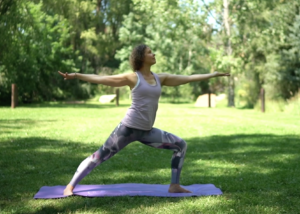Yoga is never something I did on a regular basis. I was too busy for that. I ran, biked, hiked, skied, took HIIT classes, did “Insanity” workouts at home. These were how I “relaxed” and spent my little bit of free time every day. I had no time for yoga. Poses and stretching. Really?
But, as I have turned to study Integrative Medicine and tap into my own body’s ability to heal itself, more and more data about the positive aspects of yoga keep appearing. Yoga is not just about wearing tight yoga pants and assuming uncomfortable poses; it is in fact, much more important than that. It adds another tool to my toolbelt; one that is so important, I just may not be able to do without it.
Neuroscientists are gaining insight into the powerful ways in which yoga helps to activate the healing ability of the brain and establish a positive feedback loop. The overall positive mood benefits of practicing yoga are more prominent than with other types of exercise. For example, women who took a twelve-week class in yoga showed greater improvements in mood and lowered anxiety levels than did women who spent the same amount of time energy walking.1(This is not to say walking and other forms of exercise don’t serve important roles – they do. Therefore, it’s important to incorporate multiple types of activities, including balance, cardio, high intensity, resistance training, flexibility, and relaxation).
And in another study, regular yoga practitioners came into the study with lower levels of inflammatory markers than the novices, and they were also better able to limit their stress responses than were the novices when faced with physical and emotional threats.2
Women who practiced yoga compared to the walking group showed higher levels of the feel-good chemical GABA – which is essential to proper brain function and also promotes a state of calm. (Low levels of GABA is associated with depression and anxiety). In this study, even a single hour of practice yielded a 27% increase in GABA levels.1
The yoga brain is a calmer brain, offering us more long-term mood protection than other forms of exercise.
Yoga also seems to increase the blood flow to areas of the brain associated with healing. When PET scans on yoga newbies before and after yoga training were done, they found just 3 months of training increased blood flow to the frontal lobe and prefontal cortex (feel good areas) and decreased blood flow to the amygdala (fear and fight or flight center).3, 4
And the stretching movements that go with the deep breaths are also beneficial, in they help stimulate the vagus nerve (through deep breaths and movement of the diaphragm). The vagus nerve is part of the parasympathetic nervous system, and in addition to slowing down and regulating our heart rate, respiration, blood pressure, gut function, among many other essential roles, it also provides stability to our body’s immune response, calming down the inflammatory reflex that plays a role in almost every disease, from autoimmune to irritable bowel to cardiovascular conditions and cancer.
According to researchers at New York Medical College, who have published a number of papers investigating how stimulating the vagus nerve and parasympathetic nervous system through yoga breath work helps to build stress resilience, they make the point that, “although many medicines can temporarily dampen the sympathetic system, including anti-anxiety drugs such as valium and some antidepressants, there are no medications you can take to boost the parasympathetic nervous system.”5 Yet, simple, gentle stretching and slow yoga breath practices – free and available to all- can potentially “strengthen and recharge the parasympathetic nervous system rapidly and effectively.”
And these breath practices can activate the parasympathetic nervous system within just five to ten minutes.
Yoga is not just preventive medicine, it’s restorative. It not only revitalizes our cellular health in both brain and body; it changes the brain in a protective way – so that when we come up against stressors and pain, we’re more resilient and less reactive.
And so, I bought some new yoga pants, and have recently begun my own regular practice, as I tap into the healing and feel-good centers of my brain. I’m pretty sore after the first few classes, finding muscles I never knew I had, and realize it’s a lot more challenging than I had thought. Part of the challenge is remaining mindful and present throughout the class, but I realize how important that is. Balance, flexibility, mindfulness, core strength, relaxation, and revitalization, right down to a cellular level – what more can I ask for?

References:
1. Effects of Yoga Versus Walking on Mood, Anxiety, and Brain GABA Levels: A Randomized Controlled MRS Study. J Altern Complement Med, 2010. https://www.ncbi.nlm.nih.gov/pmc/articles/PMC3111147/
2. Effect of Yoga Practice on Levels of Inflammatory Markers After Moderate and Strenuous Exercise. J Clin Diag Res, 2015. https://www.ncbi.nlm.nih.gov/pmc/articles/PMC4525504/
3. Differences in Brain Structure and Function Among Yoga Practitioners and Controls. Front Integr Neurosci, 2018. https://www.ncbi.nlm.nih.gov/pmc/articles/PMC6023989/
4. Meditation and Yoga can Modulate Brain Mechanisms that affect Behavior and Anxiety-A Modern Scientific Perspective, Anc Sci, 2015. https://www.ncbi.nlm.nih.gov/pmc/articles/PMC4769029/
5. Brown, R and Gerbarg, P. The Healing Power of the Breath: Simple Techniques to Reduce Stress and Anxiety, Enhance Concentration, and Balance Your Emotions,2012.

